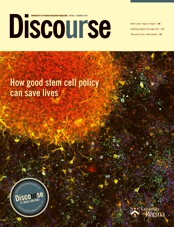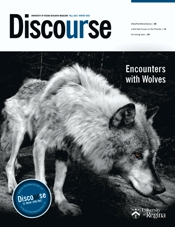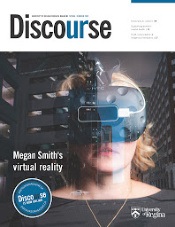International studies assistant professor says social media has fundamentally transformed the nature of most civil wars and political violence in general.

The 2011 Libyan Civil War really marked the start of the widespread use of social media as a tactic in armed conflict, according to Dr. Brian McQuinn, an assistant professor of international studies in the University of Regina’s Department of Politics and International Studies. “One of the things that came out of Libya was that all of these things that were happening, that these fighters were doing, they were often livestreaming them or posting them on Facebook as they were doing them. And so it was really one of the first conflicts that you could literally watch online.”
The conflict in Syria, however, dialed up this new strategy to a whole new level—in large part because of the sheer number of armed groups involved. In Libya, there were several hundred. Over the course of the Syrian conflict, McQuinn and others who’ve studied the civil unrest have tracked more than 3,000 different militias—most with their own social media presence. The amount of content these groups have posted online boggles the mind, says McQuinn.
“You have more hours of video uploaded to YouTube of the conflict than there have been hours in the conflict. And the conflicts have been going on for 10 years. Social media has fundamentally transformed the nature of most civil wars and, I would argue, political violence in general.”
McQuinn, who came to the U of R in 2019, has devoted his 20-year career in academia and war zones to better understanding armed conflict and peace processes. The data he and colleagues are mining these days—Facebook posts, YouTube videos, Tweets—is yielding a wealth of insights into how insurgent groups are using these platforms to recruit new members, publicize their views, and finance their operations.

The humanitarian and academic’s work is also bringing public attention to the mistreatment of civilians and aid workers—and shining a spotlight on how the companies that own these and other online platforms are largely turning a blind eye to what’s happening on their networks.
DISINFORMATION TARGETING HUMANITARIANS
With funding from Facebook, McQuinn and U of R colleague Dr. Gordon Pennycook are studying the impact of disinformation specifically targeting humanitarian groups and misinformation generally in conflict zones. (Misinformation is false information believed to be true and shared with no ill intent, while disinformation is known to be false and shared with malicious intent.) Militant groups are spreading disinformation about aid workers, then posting their names and addresses online—a practice known as doxxing. “Think of all the crazy antivax stuff that we get here. Now imagine that on steroids in conflict zones,” says McQuinn. “That's what they (humanitarians) have to deal with. They don't have the tools to understand it and track it, let alone the tools and analysis to combat it.”
The project will require travelling to the Philippines to interview citizens and humanitarians face-to-face about their individual experiences in the ongoing Mirawi conflict between government forces and pro-ISIS militants. Neither citizens nor humanitarians are sharing anything online about how they’re being treated by militant groups, for fear that doing so will damage the reputation of the aid organizations and hamper their efforts to help local people.

Pennycook, an assistant professor of behavioural science in the Hill and Levene Schools of Business, is curious to see whether theories they’ve developed in Western contexts about how people assess the veracity of, and share, online information hold true in conflict zones. “Is what we think we know about the spread of fake news and misinformation also true under extreme circumstances?”
Spoiler alert: Pennycook suspects that, given the fact that the consequences are potentially life and death, people in conflict zones are not guilty of the same kind of lazy thinking. The pair’s project, says Pennycook, is the first he’s aware of to look at the impact of misinformation on individuals. Most research in the area has focused on impact or outcomes in the aggregate—a change in public opinion, for example, or the outcome of an election.
While the team has a pretty good handle on how rebel groups are using the main social channels, McQuinn says they don’t have the same understanding of how WhatsApp, a popular messaging platform, is being leveraged in these areas, largely because it’s a closed circuit. Messages are encrypted and cannot be tracked.
“You need to be on the ground to understand how that sort of network is being used. Your message goes out to whoever is on your list, but there's a (group size) limit of 256. So that means that to get things out to communities you need to know the key people, put it out to their communities, and then it just ripples out from there.”
HARNESSING THE POWER OF AI
Together with research colleague Laura Courchesne, McQuinn is developing powerful new tools to understand militants’ use of social media. The Centre for Artificial Intelligence, Data, and Armed Conflict (CAIDAC), co-hosted by the University of Regina and the University of Alberta, will assemble the world’s largest repository of conflict-related social content—text, images, and videos—with machine learning tools that will enable people who are not experts in artificial intelligence to parse massive amounts of data.
“Misogyny is fundamental to their ideology, but they muted this in the weeks before the takeover because they knew they were getting more international scrutiny,” says McQuinn. “But now that they have taken over, it’s back.”
“Ultimately, what we're doing is building these systems that allow us to look at conflict ecosystems and allow humans to track in real time what is happening,” says McQuinn. “What are the key issues that are emerging, but also the nature of how a conflict is changing, and things that are targeting humanitarians.”
The Centre is taking machine learning a big step further. Using an approach called “human in the loop,” members of the team with deep understanding of a particular conflict, including local languages and culture, can ask the system how a specific word is being used in tweets, in relation to other words. The computer will dig through millions of posts, and report back that the word is not just correlated to this word or that word, McQuinn says, but it’s also related to these other concepts or events. Take the word women, for example. The system allows them to track how the Taliban's language about women changed. “Misogyny is fundamental to their ideology, but they muted this in the weeks before the takeover because they knew they were getting more international scrutiny,” says McQuinn. “But now that they have taken over, it’s back.”
Human-in-the-loop machine learning means McQuinn and his colleagues are learning from the machines, and the machines are also learning from them. “It’s an evolving, learning feedback loop between the machines and the people, which are then improving each other as they go along to better understand conflict.” Absent such a system, there’s no way that humans can track—let alone understand and study—what’s going on in an ecosystem of hundreds of thousands of Twitter accounts. AI has its own limitations: “Machines don't know what to look for. Even if you tell them at one time, what you asked them to look for has changed five minutes later. That’s why you need the human element. In conflict, everything is changing. You're working across modalities, you're working across languages. The armed groups are changing.”
One of McQuinn’s strengths, says Courchesne, is in building bridges and connecting dots across different disciplines to tackle complex problems in innovative new ways. CAIDAC is a perfect example of this. “Technologists really understand the technology, but they don't necessarily understand the downstream implications of how it's used,” says Courchesne, who is doing her doctorate in international relations at the University of Oxford. “On our side of things—conflict researchers and humanitarians—we typically don't understand the technology. There's this huge gap of this dual fluency. How do we create better kinds of connections between experts on both sides, to approach these issues differently?”

In addition to pulling the curtain back on militant groups’ use of social media, CAIDAC also holds the potential to better support the people and communities affected by civil wars. Being able to analyze social media content from a conflict zone at scale provides an unprecedented window into the impacts being felt on the ground. “It gives you access to their health situations and what's going on, because social media is used as the primary news source for 70 to 90 per cent of the population in some conflict zones,” says McQuinn. “It's on Facebook—their data, their news, everything from where they should run if there's conflict, to what hospitals are open, to where they should take their kids if they get hurt. All of that is being transferred through social media.”
ON THE GROUND
An early experience set McQuinn on a career-long mission to deeply understand conflict and peace.
He was just 25 in May 1999, working with the Canadian Institute for Conflict Resolution (CICR) to provide peace-building training to staff of local NGOs in Indonesia, when he got a call from the Canadian Embassy in Jakarta. Could he go to East Timor to help with the Dare II peace talks aimed at bringing an end to the civil war and escalating violence there?

McQuinn turned 26 on the flight to Dili, the capital of Timor-Leste. The local cleric’s chief of staff met him on the tarmac at the airport.
“He says, ‘We're so excited that you can be here to help. We've talked to the rebels, they're willing to come. The government officials are willing to meet. I'm leaving on the plane you just got off. Good luck.’”
“What happened afterward—the violence—became my core motivation for understanding conflict, understanding armed groups, understanding peace processes,” says McQuinn.
For the next couple of months, McQuinn worked with others in the region to build out the peace talks. They faced threats and attacks by local militia. Staff involved in the shuttle diplomacy efforts were killed. In the end, the talks failed. And thousands of people died in the violence.
“What happened afterward—the violence—became my core motivation for understanding conflict, understanding armed groups, understanding peace processes,” says McQuinn.
He would go on to do a master’s in international peace studies at the University of Notre Dame and a PhD at the University of Oxford. For his doctoral research, McQuinn spent nine months in Libya, embedded with the rebels fighting the 2011 uprising. Highlights of his work in the field include helping set up Rwanda’s National Union and Reconciliation Commission in 2001-02, and working with former US president Jimmy Carter from 2004 to 2006 to support the peace process in Nepal. In what he describes as “the best job in the world,” McQuinn was also part of a small unit of the International Committee of the Red Cross, which helped the humanitarian organization’s delegations analyze and negotiate with armed groups between 2015 and 2019.

The year 2017 marked a turning point in McQuinn’s personal and professional life. Two things happened: His son Alexander was born. And a number of his colleagues were killed in conflict zones. “I had a moment. I still loved my work. But my son only has one father. I decided it was time to come home.” Two years later, he secured an academic position with the U of R.
SOCIAL MEDIA HELPS TALIBAN’S TAKEOVER OF AFGHANISTAN
McQuinn’s latest findings offer compelling evidence of the value of mining and then analyzing mountains of social media posts. Their Afghanistan team was able to show that the Taliban relied heavily on social media in its takeover of Afghanistan. CAIDAC is publishing a full report on this research in conjuction with a New York Times investigation based on the findings.
The research also shows that the Taliban rolled out a “repertoire of influence strategies” in the months leading up to the takeover. “There's a playbook that they followed that spelled out tactics literally down to the day before they have their attack,” says McQuinn. “Then they start the social media about this sort of utopia that is created after their attack and what it's like to live under Taliban rule.” That playbook, he says, was disseminated to millions of followers in late summer. “We've been able to provide sufficient evidence to say social media is responsible for the rollout and success of their plan.”
Equally disturbing, the research suggests that social media platforms may be profiting from the Taliban's use. The team is hoping to publish their results about this in the coming months.
BUILDING PEACE
The suffering McQuinn witnessed in conflict zones is a big part of what drives him.
Understanding how armed groups work—including their use of social media—is key to stopping violence against civilians and humanitarians and building peace.

“When you're talking about my motivations, I don't really have a choice,” says McQuinn. "You either ignore what's going on in the world, or you don't. And if you don't ignore it, then you have no choice but to do something about it in whatever way you can, based on your set of skills and abilities.”












